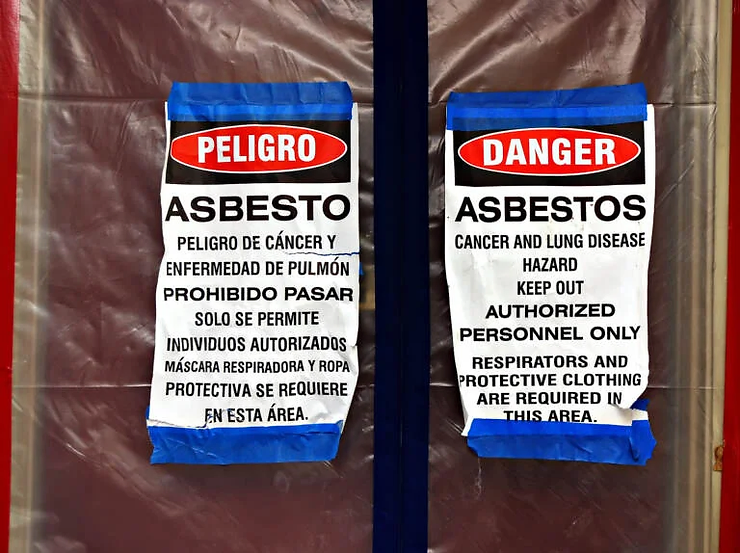While asbestos is commonly found in homes, it is also highly prominent in schools and commercial buildings. The majority of NYC public schools were built during the peak of asbestos usage. In many cases, the asbestos containing material is not removed due to the hazards that can arise from improper removal- such as the release of fibers into the air. So, asbestos remains on ceilings, floor tiles, insulation, pipes, wiring, and embedded in bricks and mortar.

Without removal, the asbestos containing material can serve as a danger to children. Asbestos is especially dangerous in schools due to the heavy foot traffic on the floors each day and the peeling or picking of walls by bored students. Moreover, most NYC public schools are so old that they are deteriorating naturally, without any outside source of damage. Damaging the asbestos containing material (ACM) releases tiny needle-like fibers into the air that can cause lung damage and a multitude of cancers.
If the school chooses to remove the ACM, they must do so in compliance with multiple laws and use a licensed professional. Here, we describe an instance where we helped a school safely remove the ACM, and helped to keep the school a safe place for the children to learn.
Step one: Assessment and Inspection
The first step was to send one of our licensed asbestos inspectors to the school. ACMs are inspected, samples are collected and sent to the laboratory. After the lab results are received, a report is generated. For this case, the lab results indicated dangerous amounts of asbestos fibers floating freely in the school. These fibers were likely sourced from chipped or deteriorating tiles on the school floor.
Step two: Preparation
Before any removal work could be done, the affected area had to be prepared. This includes sealing off the area to prevent asbestos fibers from spreading to other parts of the building. HVAC systems must be shut down to prevent the spread of fibers through ducts. Plastic sheeting and duct tape was used to seal windows, doors, vets, and other openings.

Step three: The Asbestos Removal Process
Removal of ACM must be done by licensed professionals. Our professionals wear personal protective equipment (PPE) including respirators, coveralls, gloves, and eye protection. Coveralls are disposed of to ensure fibers do not cling to clothing and spread to other locations. Additionally, before beginning the removal, we wet the ACMs using a misting system or a handheld sprayer, depending on the surface area. Wetting the ACM suppresses dust and fibers, reducing he risk of airborne contamination. After the areas were wetted, we began removing the ACM by cutting and sawing. Cutting and sawing is appropriate for floor tiles or other non-friable materials, where scraping or peeling may be better for friable material like insulation. We also used HEPA filtered vacuum cleaners to minimize dust generation. After sawed out, each floor tile was handled very carefully. Further damaging ACM can release even more fibers into the air, so they must be handled with extreme care.
Step four: Disposal
After we removed all of the asbestos tiles from this school, we carefully placed them into sealed and labeled containers. Transport was done in accordance with local regulations by licensed asbestos disposal contractors. The ACM waste was transported to an approved landfill site.
Step five: Cleaning and Reinspection
Once the ACM is successfully removed and disposed of, it is important to decontaminate the area. Our professionals thoroughly cleaned the affected area with HEPA vacuum cleaners and damp wipes. Any residual asbestos fibers were picked up and removed by these tools. All personal protective equipment was removed inside of the containment area via decontamination units to prevent the spread of fibers outside of the enclosed work area.
When cleaning was completed, we performed a reinspection to ensure all ACMs were properly removed and cleaned up. After the reinspection was conducted, the area was deemed clean and safe for reoccupation. Air monitoring was also conducted after removal to verify the airborne asbestos levels were below the regulatory limits.
Step six: Documentation
Due to the serious nature of asbestos infestations, detailed documentation and records of the asbestos removal process must be kept. This includes inspection reports, survey results, air monitoring data, clearance certificates, waste disposal manifests, and receipts.
With our help, the students and staff were able to return to the school shortly after the asbestos removal process. Completing this process quickly and effectively is essential. The sooner the process is completed, the sooner students can continue their education. But, the process should never be rushed- as asbestos removal requires proper procedures to ensure no residual fibers are left. At Lead and Mold Detectives, we make sure asbestos gets taken care of quickly and correctly.
